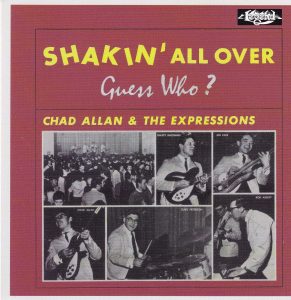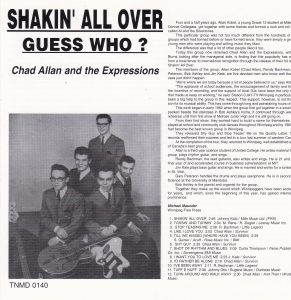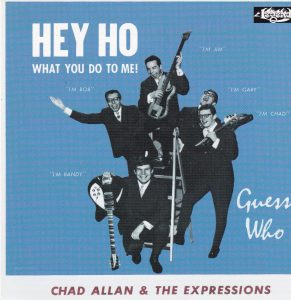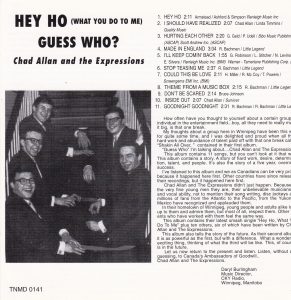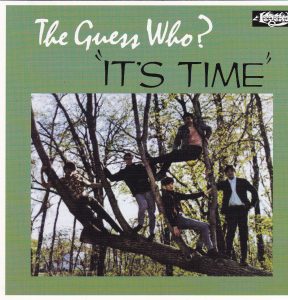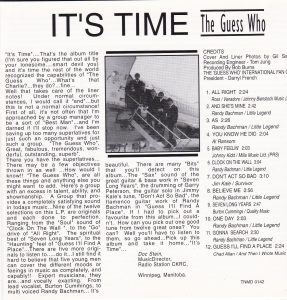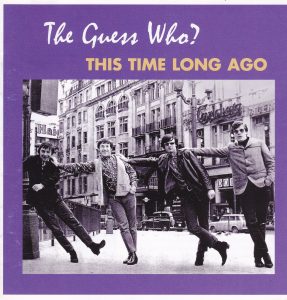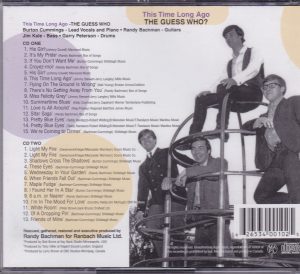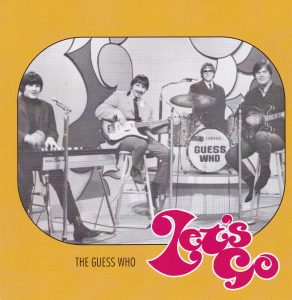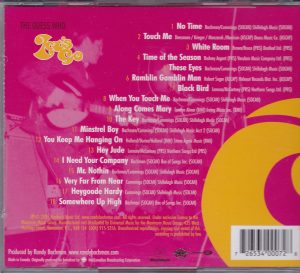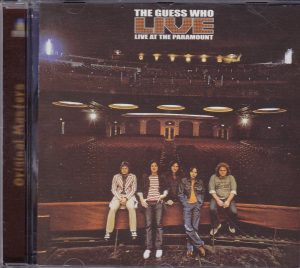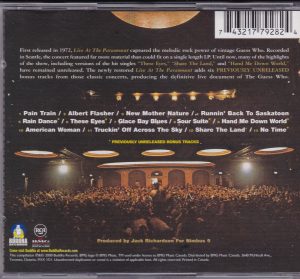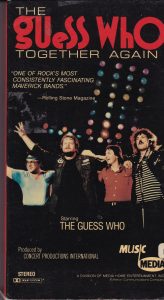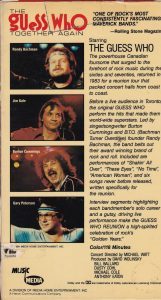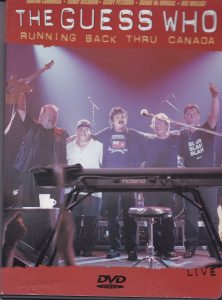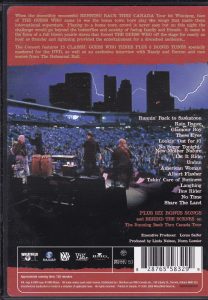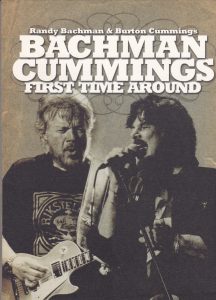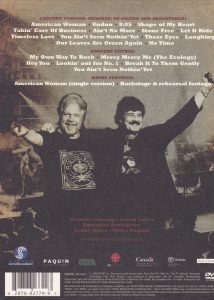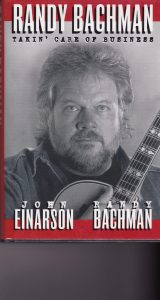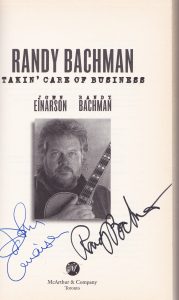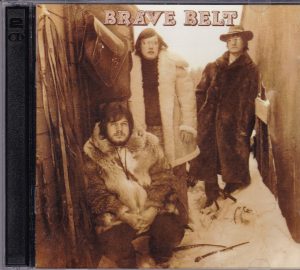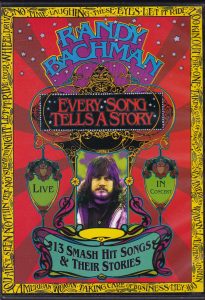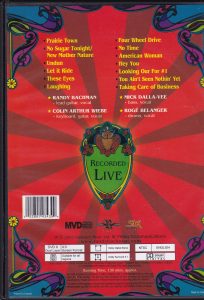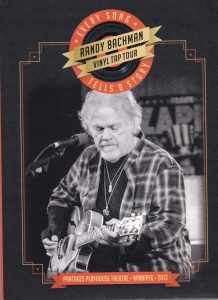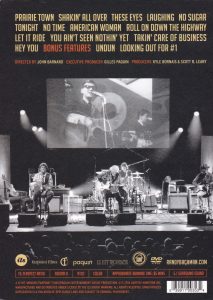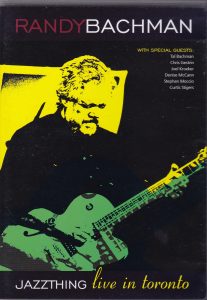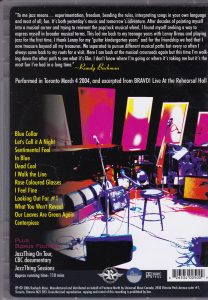I was in grade 9 in 1964 when I first heard the group’s “Stop Teasin’ Me” on a 45 rpm single played on local Winnipeg radio. It fitted in perfectly with the British Invasion songs on the radio at the time and I recall being majorly surprised that it was written and sung by a Winnipeg group, Chad Allan and the Reflections. I instantly became a fan and later bought their first album released in January 1965.
I was in a high school group sponsored by Kiwanis for guys called the Key Club and we hired them for a dance that winter at our school Silver Heights Collegiate. It was a huge success and I would go on to attend other dances with them elsewhere in the city. The album went to #1 in Canada and was on Billboard in the States, which led to a short US tour with other acts. I remember being in Minneapolis back in the summer of 1964 after the “Shakin’ All Over” single came out; it was played as a ‘new hit’ and they were announced on the radio as “Guess Who?”– which quickly became the band’s new moniker.
In the summer of ’65, they recorded with American Scepter Records, releasing three 45s: “Hey Ho”, “Tossin’ and Turnin'”, and “Hurting Each Other”– the latter recorded with black female back-up singers. But playing community halls and school dances continued to pay the bills. Hey Ho was pianist Bob Ashley’s last album.
With his departure, Burton Cummings of the second-most popular group in town, The Deverons (who’d had a minor hit with “Blue Is the Night”), who had destroyed the Winnipeg Arena piano at the Gerry and the Pacemakers show, dancing on it in his Beatles boots, now joined to play keyboards and share vocals, briefly, with Chad. It’s Time, the group’s slicker third album was released in 1966 with Chad singing leads on the two 45 rpm singles released: “And She’s Mine” and “Believe Me” (the latter a raver with wild Zombies-like keyboard soloing by Burton).
By now, Chad’s vocal cords were ratched by recurring nodules and it was clear to the rest of the group that the future was with Burton anyway. Silver Heights’ grad Beach Boy-looking Bruce Decker briefly played for a few months with the group on rhythm guitar and appears on the cover on the left side of the cover of It’s Time. (He later would die, tragically, as a hitch-hiker in a fluke car accident on Portage Avenue.) I saw this transitional lineup at one of the Guess Who’s favorite venues, River Heights Community Club, and they were still getting their bearings minus all the Chad backlog material. BTW/Online, you can actually find songs recorded live at this venue in 1966 when Chad was still with the band. Lots o’ energy on a wide swath of material going back to ’62.
In 1997, Randy re-released the first three albums on CD and later previously unreleased material covering the 1967 period when they reunited with Chad on CBC Manitoba’s “Let’s Go” tv show. You can hear them (minus Chad) doing an early take of “These Eyes”, 45s such as “His Girl”, “This Time Long Ago”, and “Flying on the Ground Is Wrong” (an early Neil Young/Buffalo Springfield cover). Hits of the day, such as “Light My Fire” and “White Room”, were boldly and effectively covered.
The gig on “Let’s Go” helped to pay off the disastrous misfire trip to London in 1967, which landed the band in huge debt. They, incidentally, fooled the producer to get the gig by pretending to know how to read music; their covers were actually learned from listening to the original hit records themselves. Hits coolly covered included; “Time of the Season”, “Along Comes Mary”, and Jim Morrison’s/The Doors’ “Touch Me”. There is also a sampling of songs from The Wild Pair, a soda pop promotional record, including: “Heygoode Hardy” and The Kinks-inspired “Mr. Nothin'”. The promotional record was heard by T.O. producer Jack Richardson, who mortgaged his house to facilitate their 1st mammoth 45 hit of “These Eyes” in 1969 and the first album for RCA Victor.
BTW/I almost got the nerve to meet Chad in 1967 when he was a mere mortal recovering from surgery (Allan Kowbel was his real name) living across the street from a school buddy. In the last decade, I finally got the nerve to write him and he kindly signed some Regenerator Records albums of previously unheard Reflections era material as well as the following olde poster. Chad was an interesting guy (he started the band in 1962, then lost out on all the big pay-days). Around 2000, I read that he had been visiting old folks’ homes with his accordion (his first instrument) and playing real oldies. In 2017, he suffered a stroke and was admitted to a BC hospital–no news of him since.
Dec. 2, 2023 update: Chad passed recently (March 23, 1943-Nov. 21, 2023)
Probably the most memorable Guess Who shows I ever saw were at University of Winnipeg in 1967-8 when Bachman wore a Union Jack flag and at Winnipeg’s outdoor theatre Rainbow Stage in spring, 1970, after they’d scored hits with “These Eyes”, “Laughing”, “No Time”, “Undun”, and “American Woman”. That was a fantastic, impressive concert. BTW/They had started using Winnipeg-made Garnet amps at this time because of the increased demands for arena shows.
At that moment, we Winnipeg kids were starting to believe that Winnipeg was the centre of the musical universe (another world-touring Wpg. band, BTO, was soon to follow). The Guess Who was always proud of and acknowledged their Winnipeg roots in their introductions and numerous Winnipeg shows over the years, even investing in the city’s Salisbury Houses (one of which showcases Cummings-Bachman memorabilia).
The legend, though, of The Guess Who is best experienced through any of their compilations.
The remaining four members sallied forth out of the original band’s ashes and had the hits, mainly written by Bachman and Cummings.
Giving credit where credit is due: re. the many band members. Incidentally, another popular Winnipeg band called Brother, contributed a few members and songs. The Guess Who, for a good chunk of this period, was driven by two lead guitarists accompanying Burton (after Randy left because of illness) : the “Hang on to Your Life” and “Share the Land” stuff. There is no telling how many more hits Kurt Winter might have contributed had he lived longer. BTW/IMHO/ Jim Kale and Gary Peterson never got the credit they deserved for their fine, tasteful bass and drum work.
The hits happened from 1969 to 1975, at which point Burton disbanded the band in T.O. during the “Dancin’ Fool”/Domenic Troiano version.
Speaking of wild guitars, this album was about as heavy as the group ever got on their only live album, which spawned one hit: “Runnin’ Back to Saskatoon”. The one line that stands out for me from this one was Burton screaming, “Baby, lost her mind!!”
Next, Burton went his own way and released successful solo albums, some recorded with the former bassist of my 1968-69 folk trio, Ian Gardiner. Jim Kale owned the group’s name at this point and, after some haggling, the hatchet was temporarily buried, long enough to mount a 1983 reunion tour which showed that the original foursome group still had its chops. The result was an LP, and (what’s become a rare) VHS featuring new songs including : “What’s Gonna Happen to the Kids?”.
17 years later in 2004, the group tried another reunion (sans Jim Kale) with two of the post-foursome members in Winnipeg in 2000, which was recorded on DVD. It’s a wild affair during a thunderstorm down near The Forks (Assiniboine and Red Rivers) and includes extras including interviews and rehearsal material.
And since then there’s been a number of Bachman-Cummings gigs, though the above vid was hardly their first time around! (In passing, Randy went through bypass surgery to avoid early death. And Lenny Kravitz’s dramatic recording of “American Woman” revived interest in the Guess Who’s music.)
The Randy Years
After leaving The Guess Who, ironically at its 1970 peak, Randy did an unsuccessful solo instrumental album, Axe, for Victor before trying to mount another band. He also recorded with a variety of other artists and started singing more.
He has reminisced many times about his musical past on his CBC Radio show and in many shows which he has headlined as a solo act. The above book was co-written with John Einarson, the author of Shakin’ All Over–the wonderful archival book about Winnipeg bands of the ’60s.
Randy’s first band in the early ’70s was Brave Belt which included Winnipeggers C.F. Turner on bass and edgy vocals, brother Rob Bachman on drums, and rhythm guitarist-singer Chad Allan. His first instinct had been to do a folksy Buffalo Springfield kind of band with Chad vocalizing their two radio hits: Chad’s “Dunrobin’s Gone” and “Another Way Out”. But if you listen to C.F.’s “Waterloo Country”, you see which way Randy and the remaining members would go next.
Randy morphed into his second world-famous band and toured widely with a heavier sound for a few years in the mid-’70s. He was starting to vocalize more and add some of his Lenny Breau-influenced guitaring to BTO songs like “Blue Collar” (by C.F. Turner) and “Lookin’ out for #1”. This interest in his former jazz guitar wunderkind-mentor led to the re-release of several Lenny Breau albums as well as previously unheard material, including a live video. Lenny fans have Randy to thank for the current surfeit of Breau material, though much of it went quickly out-of-print, scarce, or rare.
The Bachman videos are all interesting including one live reunion with BTO. Colin-Arthur Wiebe does a reasonable facsimile of the Burton vocals for the hits.
Another good entertaining show featuring the catalogue.
Caught up in the Lenny re-release swirl, it’s not surprising that Bachman would try jazz and write and record some of his own material (with his wife on occasional vocals). I first met him at the Yardbird Suite in Edmonton to get some things signed. He is always very friendly in post-show socializing.
One more jazz DVD by Randy.
As of this date (2020), Burton has recovered from a recent L.A. car accident and, like Randy, continued to tour in 2019. Not a bad run for two Winnipeg guys–Randy (58 years: 1962-2020 so far) and Burton (55 years: 1965-2020). The Guess Who will forever be one of the Canada’s best-loved bands and it will continue to be said that they led the way for other Canadian performers to the possibility of long-time success south of the border and elsewhere in the world.

